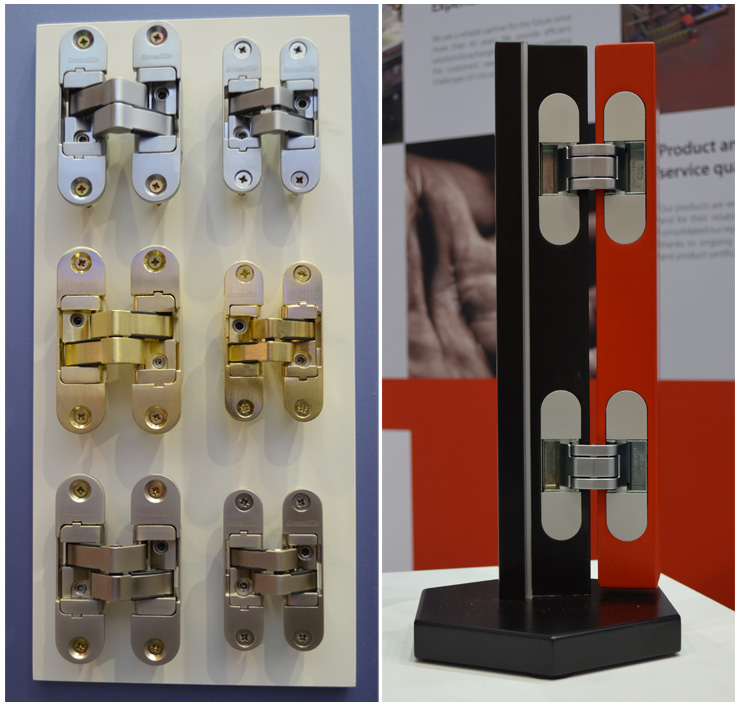Hidden hinges for interior doors: features, benefits, installation
Hinges are placed on swing doors and are an integral part of them. They ensure the rotation of the wings around the side ends of the box and act as a carrier mechanism, without which the door leaves simply will not open. There are many types of hinges, but the most aesthetic are hidden hinges for interior doors. They remain invisible from the outside, and the doors can open 180 degrees.
Concealed hinges - design features
In accordance with the regulations, door hinges must provide:- canvas mobility - its free opening and closing;
- reliable fastening throughout the service life;
- exclusion of spontaneous separation of the sash from the door slope;
- fixing the extreme, and in some cases intermediate, positions of the canvases;
- trouble-free operation during the warranty period.
Well-known companies on the world market, specializing in the production of window and door fittings, produce high-quality hidden hinges, interior doors with them are able to withstand the opening-closing cycle of the leaves up to 200,000 times.
The hidden loop is made of tsamak - an alloy consisting of four metals. It includes aluminum and magnesium, as well as copper and zinc. Tsamak is harmless to humans, has sufficient strength, excellent casting properties at a low melting point and a smooth surface. Chrome, brass and nickel-plated coatings are applied to the finished hinges, which can be glossy or matte.

The design of the invisible loop itself consists of a hinge hidden in a metal case, and it is connected to the canvas with a lever. It, in turn, consists of two parts fastened together with a common screw. The lever, when closing the door, hides in a recess, and it is not possible to see it from the outside.
When choosing hidden hinges, it is necessary to pay attention to the direction of opening the sash, since the hinges are divided into left, right and universal, installed on either side of the door frame.
Also, hidden-type hinges can be adjusted, but cheaper models are produced without it.
Benefits of a hidden door hinge
Hidden door hinges have become popular due to their undeniable advantages:
- the possibility of adjusting an already installed sash without dismantling in three directions;
- uniform fit of the leaf to the door frame and ensuring the same gaps on all four ends;
- large opening angle, which is essential when moving large furniture or other items;
- high reliability provided by a special design;
- external invisibility, which allows you to make high demands on the aesthetics and design of the interior door;
- additional protection against the penetration of unauthorized persons into the premises - it is not possible to cut or knock down a hidden loop in order to remove the canvas;
- the absence of subsidence of a heavy door leaf.
Where and how are hidden door hinges installed?
The choice of a hidden hinge is made, first of all, focusing on the mass of the door leaf. One model can withstand a load of 40 kg, and the other 200 kg.
It is logical to note that the stronger the design of the hinge, the more expensive it is, therefore, in the case of installing a light sash, you should not overpay and buy massive fittings. For each specific option there is an individual solution.
Invisible hinges are installed in non-folded and folded door structures. Hidden interior doors, externally merging with the wall, are completed only with such hinges. In this case, they are completely invisible.

The material for the box and canvas can be:
- wood;
- aluminum;
- steel.
Hidden hinges are mounted at the end of the door leaf from the side of the jamb and into the box itself by inserting and fastening with self-tapping screws. The work is carried out with extreme precision so that no gaps appear when the door is closed.
As a rule, hidden hinges on the sash are installed in the amount of three pieces. This provides additional reliability and a long service life.
After hanging the finished canvas on the box, it is adjusted with a hex key:
- horizontally - aligning the sash with respect to the door jamb with the help of an adjusting screw located on the surface of the hinge;
- vertically - adjusting the gaps between the leaf and the floor, or between the frame cross member and the upper end of the sash by scrolling a vertically located screw;
- on the clamp - adjusting the uniformity of pressing the web to the box using the adjusting eccentric.

It should be noted that not all models of hidden loops can be regulated, but only those in which this function is present.
Which loops to prefer
Structurally, any swing and folding doors must have hinges. Other types, such as a sliding, hinged or sliding hidden interior door, are equipped with rollers and guides along which the canvases move.
Loops are:
- overhead - installed in the form of patches;
- mortise - fastened in special slots made;
- hidden - go deep into the body of the canvas and box;
- screw-in - welded to the sash frame and jamb;
- bar - used for pendulum doors.
Each of the designs has its own characteristics and is intended for specific purposes. The overhead hinge is the most common, especially for lightweight economy class doors. Mortise doors are placed on entrance groups and heavy canvases, screw doors are placed on light metal doors, and bar doors are made specifically for doors that open in both directions.
Hinges of a hidden type do not stand out from the general plane of the door and this is their main feature.
Which hinges to purchase for a door depends on its purpose, location, weight and requirements imposed by the owner or dictated by the overall design of the room. The choice is huge!
